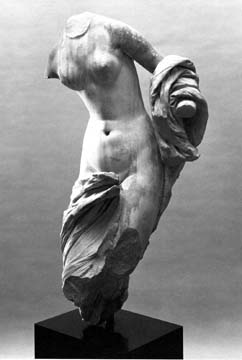
Unknown
Roman
Aphrodite (or Nymph), 1st c. BCE
marble
39 in.
Gift of Wright S. Ludington
1973.52
COMMENTS
The slim, lithe figure and high, firm breasts of this superlative statue identify it almost assuredly as an Aphrodite or nymph. The graceful and voluptuous young woman stands with her upper body bent gently forward and slightly tilted to the right, her weight primarily borne by the left leg, the right seemingly more advanced than the left. Though it is curiously reminiscent of the work of Seventeenth Century Mannerists in the elongated elegance of the torso, it is without any doubt a product of Classical antiquity. Were the right shoulder somewhat lower, one might speculate that she was in the familiar classical pose of stooping to adjust her sandal. One can only guess what the support may have been or just how the right hand and lower arm were held. The head undoubtedly tilted to the right, in a curve that completed the curve of the torso. Even with the head missing, the beautiful upward movement to the left side is impressive, viewed from any angle. Seen from the front, the reverse curve of the drapery hanging over the left arm is a strong counter to the curve and motion on the right side. The left hand must have grasped the end of the drapery that comes up across the right thigh.
The modeling of the body subtly conveys the sensuality one associates with the goddess of love, or with a nymph. Even in its present state--and the marble was no doubt once highly polished--the skin appears rounded and soft. Note particularly the pronounced dimples above the buttocks, the deep navel, and the bulge of the mons veneris set off by the deep crescent crease above. The sensuousness of the figure is perhaps most striking in left profile, where the rich, heavy folds of the mantle swirling around the back of the body over the buttocks and up over the left forearm accentuate the subtle, somewhat hesitant forward tilt of the torso. The linear quality of the folds, which are richly undercut to create deep shadows, emphasizes the sensuousness of the pose. The rippling patterns and the deep undercutting illustrate the concern with the play of light and shadow in drapery forms during the late Hellenistic period.
As to condition of this statue, the head is broken from the neck and now lost. The right arm is missing from below the deltoid, the left preserved from the shoulder to the mid-forearm. The lower parts of the legs are lost: from the lower thigh of the left leg and from the area of the knee of the right. The heavy drapery (mantle) is broken and missing near the upper left thigh and at a point below the broken left arm where it would have ended. A broken circular spot on the drapery on the right indicates an original strut, presumably to a support. Minor abrasions, encrustation, and discoloration are apparent at scattered points. Clear marks of the claw chisel can be seen on the torso behind the right arm and near the breasts.
- Mario A. Del Chiaro, Classical Art Sculpture, SBMA catalog, 1984, pp. 41-43
